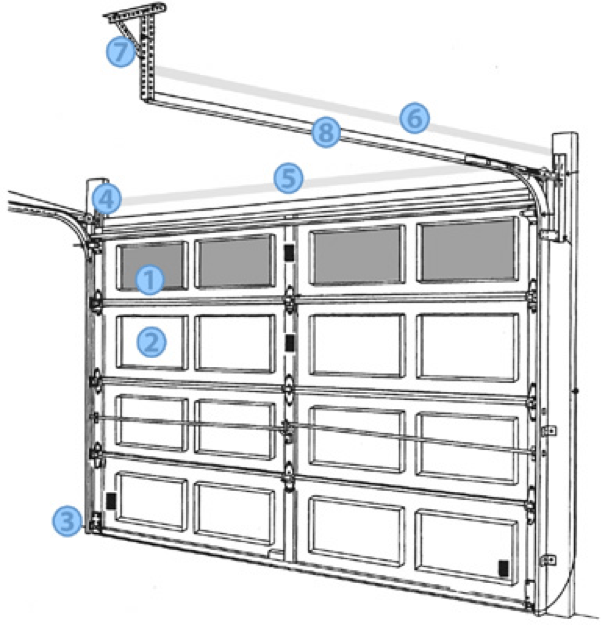A garage door consists of more than the door but many different small parts. Various components may break down as your door experiences wear and tear, resulting in functional issues. Our garage door components diagram makes it easy to learn parts’ names and functions to diagnose and fix problems faster.
- Window lite: This glazed section is available in acrylic or glass. Depending on the material you choose, you can increase or decrease the amount of light that enters your garage for greater visibility.
- Sections: Sections consist of steel panels with an interconnected system of stiles, rollers and hinges for greater reinforcement.
- Bottom bracket: The bottom bracket offers superior support, making it the ideal place to attach the lifting cables due to this bracket’s superior support. Garage door bottom brackets are on the lower corners of a garage door. The corner brackets help to hold the door’s bottom roller in place and attach to the extension or torsion spring cable.
- Cable drum: Grooved drums on the torsion spring shaft allow lifting cables to wind when the garage door opens. There are three main types of cable drums. The first is a standard lift, which is on most residential garage doors and enables the door to remain balanced as it opens. The second is vertical lift, standard in warehouse settings and features elevated grooves that wind toward the shaft for a vertical lift. The third is a high lift, which combines standard and vertical drum designs to lift the door vertically rather than horizontally.
- Torsion springs: These components wind a cable on drums to open and close the door. A torsion spring for a garage door consists of a large-gauge steel wire coil that uses torque — or rotating force — to counterbalance the door’s weight. When the garage door closes, the spring twists to store rotational energy. The spring opens as the door opens and the door returns to equilibrium.
- Extension springs: These springs extend along both horizontal tracks. An extension spring connects to cables to help pull your door open. As the door opens, the springs retract, and the wires pull at a consistent speed to counteract the door. When the door closes, the springs extend again to release the door to its original position.
- Rear track hanger: The track guides a section to raise or lower garage doors. Installing a rear track hanger allows you to securely mount the track to the ceiling in residential applications. Most versions of this kit come with all of the parts you need to accurately assemble the hanger.
View the garage door diagram below to see how each part fits together.

Track Types:
- Standard radius: Standard radius tracks are the most popular track options for residential use and require 15 inches of headroom to accommodate the curved track and additional track components and equipment.
- Low headroom with front mount spring: Most applications only use a low headroom with a front mount spring when you have 8 ½ to 12 inches of headroom to ensure the door operates properly. A low headroom with a front mount spring or a dual-track contains another horizontal track that helps to move the door’s top section up and down.
- Low headroom with rear mount spring: Another option for limited headroom is a low headroom with a rear mount spring. This mount type is typically only an option if the door has 0 to 8 inches of headroom.
- 25-degree track: A 25-degree track is typical when the garage door features handles or windows. The angle of the track helps to avoid disruptions from the handle or window when opening or closing the door and is ideal when plenty of headroom is available. The most common use of a 25-degree track is in combination with a high lift track to provide enough room for locks or decorative hardware on the outside of the door.
- High lift: A high lift track is ideal when there are over 2 feet of headroom and additional clearance for a workspace. Garage door owners often use a high lift track as it allows the track to avoid other obstacles in the garage, such as a doorway.
- Vertical lift: A vertical lift track is preferable for spaces with room for the door’s height and an additional 12 inches. Installing a vertical lift is ideal when a garage requires a significant amount of vertical workspace.
Track Components
Garage doors consist of three track components, with the first being the vertical track, which is on either side of the opening. The other two components are the horizontal track and the radius. The radius of the track is part of the horizontal track and is available in sizes such as:
- 10 inches
- 12 inches
- 14 inches
- 15 inches
- 20 inches
- 32 inches
Standard Heights
Sections that make up the standard height are available in 18, 21 or 24 inches high and can aid in creating several different height configurations, such as:
- 7 feet high – Typically four sections high
- 8 feet high – Typically five sections high
Extended Heights
Extended heights can aid in creating any garage door height you need. Using extended heights can aid in creating garage doors as tall as 30 feet.
Extended Widths
Extended widths operate similarly to extended heights and can help you create garage doors as wide as 40 feet.
Headroom Chart
- 4-1/2’–10″ – low headroom track
- 10″ – standard track/extension spring
- 12″ – standard track/torsion spring
- 14″ or more – required for operator



